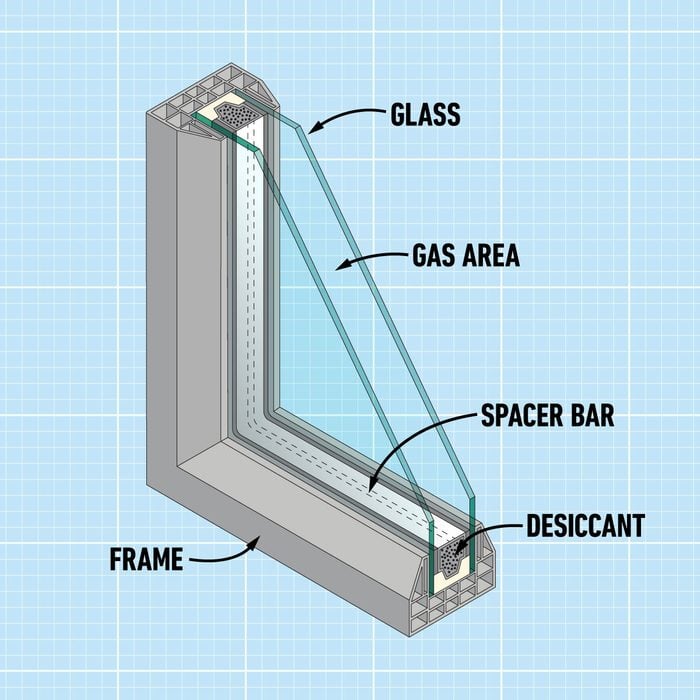Homeowner’s Guide To Double-Glazed Windows
Updated: Nov. 24, 2023

The thermal insulation that double-glazed windows provide can make a difference to your energy bill, but that isn't the only reason to consider them.
My house has an enormous picture window that looks out over Monterey Bay, but the view isn’t as picturesque as it could be because a patch of cloudiness covers half the window. That means the window is double-glazed, which is a good thing. But it also indicates the gap between the panes is no longer sealed, and that’s bad. We need to replace it.
Double-glazed windows came on the market in 1952. Today, a little more than half of American homes have them. You’re more likely to find them in the Midwest, where winters are really cold and least likely to find them in the South.
Because they prevent heat transfer and reduce energy costs, double-glazed windows are a sound investment. Here’s what you need to know.
On This Page
What Is a Double-Glazed Window?
By itself, glass isn’t a good insulator — its R-value is less than one. However, when you install two panes of glass with a sealed gap between them, you increase the insulation value of the window up to five times, depending on the gas that fills the gap. That’s the principle of double-glazed (aka double-pane) windows.
A double-glazed window comes pre-manufactured in a frame of wood, composite or some other non-thermally conducting material. The frame includes spacers that keep the panes separated by a quarter to half an inch. Manufacturers usually replace the air in the gap with an inert gas like argon, xenon or krypton.
Krypton is preferred because it insulates the best and won’t dissipate through the glass. To keep the gas contained, the panes must be well sealed against the frame. If the seal breaks and moist air gets into the gap, the window turns cloudy. The only remedy is to replace it.
Benefits of Double-Glazed Windows
Double-glazed windows can make a big difference in energy efficiency, but they aren’t for every home. Because they’re pre-manufactured, they can look out of place in an older structure. Moreover, if the structure isn’t well insulated, they won’t save much in energy costs.
Focusing on the positive, here are some of the main benefits of double-glazed windows:
- Thermal insulation: You install double-glazed windows to prevent heat transfer through the glass. That way your HVAC system doesn’t work as hard to maintain the climate in the house, and your energy bills go down.
- Sound insulation: A double-glazed window absorbs sounds from the outside and creates a quieter indoor space. This can make everyone in the house feel more comfortable.
- Security: If an intruder tries to get into your house, they’ll have a tougher time breaking through two panes of glass than a single pane. Windows made with tempered or laminated glass are even more secure.
- Reduced condensation: The temperature differential between the inside and outside of a double-glazed window is smaller than a single-pane window. That means there’s less chance of indoor moisture condensing on the window and promoting mold growth.
The main drawback with double-glazed windows? They aren’t repairable. If the glass cracks or the gas leaks out, the only option is to replace the window. And double-glazed windows aren’t cheap.
How Much Do Double-Glazed Windows Cost?
On average, around $1,000 per unit installed, but there’s a wide cost range from $300 to $6,900. This is due to a number of factors.
Window size
The larger the window, the more expensive it is. Here are some typical prices, according to size, with installation included.
- Small (bathroom, basement or kitchen single-hung windows): $300 to $750.
- Medium (standard single- and double-hung windows): $400 to $1,850.
- Large (bay and picture windows): $650 to $4,500.
Frame material
Fiberglass and steel tend to be the most expensive materials. Composite and wood are next. Vinyl and aluminum are budget choices that cost 30% to 50% less than the most expensive ones.
Window style
Double-hung windows with two movable sashes are most expensive, followed by single-hung, bay and sliding windows. Each could cost in excess of $3,000 installed. Casement and picture windows are a comparative bargain, with prices around half as much.
Type of glass and gas
Most people go with clear-tempered or laminated glass, which cost about the same. Choosing frosted glass or e-coating adds a little over $100 per window unit. The most common fill gas — argon — also happens to be the least expensive. Expect to add about $300 per window if you choose krypton.
DIY vs. Pro Installation of Double-Glazed Windows
Installing double-glazed windows yourself is definitely possible. But it isn’t recommended, primarily because manufacturers tend to make professional installation a condition of the warranty.
You also have to think about the building permit. You’ll need one if you change the size of the window opening.
If you have the relevant building skills, there’s nothing to stop you from getting the permit and doing the work yourself. Don’t forget you’re paying premium prices for the windows, though, and the security of a workmanship warranty may help you sleep better.
